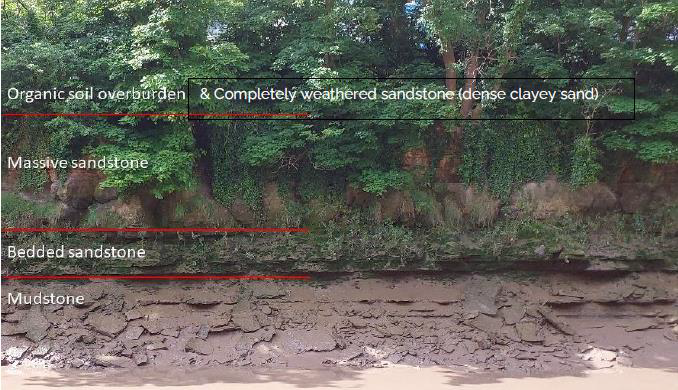Bristol City Council’s £11.9M project to reinforce high-risk river walls along the New Cut of the River Avon is advancing with long-term repairs.
Permanent repairs as part of the second phase of the New Cut river walls stabilisation project began last month. This follows the completion of the first phase of long-term repair works, which began in December 2024.
The £11.9M scheme to address erosion and instability risk along the New Cut of the River Avon in Bristol is one of a number of key harbourside infrastructure safeguarding projects in the area.
The project involves the reinforcement of high-risk retaining walls along the Floating Harbour and New Cut and a five-year stabilisation programme for long-term resilience.
Client Bristol City Council is supported on the scheme by designer Hydrock now Stantec and principal contractor Alun Griffiths.
As part of the project, the team is currently fixing two failed riverbank locations – one on the south bank at Langton Street Bridge, also known as Banana Bridge, on York Road, and one alongside Cumberland Road on the north bank, 900m downstream and to the west of Banana Bridge.
Emergency temporary repairs to stabilise the river wall either side of Banana Bridge began in July 2024. This involved 600 stacked and tied 1t bag toe weights, as well as rebar stakes, on the riverbank to reduce the tidal pressure on the wall ahead of developing the permanent works design.
The permanent repairs cover the installation of a sheet-piled retaining wall at the top of the bank to stabilise York Road, building a concrete piled wall behind the existing river wall, and planting trees and vegetation along the stabilised slope.
The second phase of the York Road river wall repairs will initially focus on the Banana Bridge site, where two sections of stone retaining wall either side of the bridge abutment have been gradually pushed out into the river and effectively failed.
The team started work at Banana Bridge first, because the tiltmeter monitoring equipment installed at the site measured continued movement.
A project team representative told GE that the ground conditions at Banana Bridge comprise superficial soils of made ground and soft alluvial clays and silts, overlying mudstone, beneath which lies Redcliffe Sandstone.
Banana Bridge strata
The provisional design option for the Banana Bridge project involved installing piles at the carriageway.
“The initial sketch showed anchored bored piles, but due to the proximity of sensitive services and considerations of stability under plant loading, a vibration-free pushed sheet piling system was implemented,” the spokesperson said.
“The anchors were eventually replaced with buttressing sheet piles, providing greater design certainty and avoiding clashes with local services.”
The overall design is still being finalised, but the project team expects to replace the Odex bored piles behind the existing wall with push driven sheet piles.
“Regardless, the two sets of piles are tied together using a reinforced concrete (RC) ground slab and a skeletal revetment slope including scour protection using Geobrugg products, all of which offer a 120-year design life. The interim area is stabilised using screw piles to enable plant access,” the spokesperson added.
“For future projects, the observed issues strongly suggest that a similar approach will be undertaken in areas of the New Cut of similar instability and geological characteristics.”
In contrast to the Banana Bridge site, where soft and loose superficial soils feature behind the failing river wall, the channel sides of the Avon New Cut further west at the Cumberland Road site and beyond are primarily composed of sandstone, both bedded and massive, resting on mudstone.
“The main challenge is the extreme tidal conditions, with a range of up to 7m between high tide and low water riverbed level, coupled with high storm and tidal flow rates that carry small to moderate-sized scree. This results in mechanical and hydraulic erosion of the channel sides, particularly at the lower levels,” the spokesperson explained.
“The masonry walls are founded on the lower-level mudstone, which was notched to create a foundation platform. However, the mudstone, being a weaker argillaceous stratum, erodes more quickly than the overlying sandstone. This leads to the loss of the wall foundation bed and undercutting of the upper sandstone strata.
“From a design perspective, it is evident that while the mudstone has remained intact globally since 1809, it is no longer suitable as a near surface foundation stratum from a continued serviceability point of view.”
Typical New Cut strata at Cumberland Road
As a result, the project team has opted for a micropiled and braced system as the most viable solution for the Cumberland Road site.
At this site, there is more rock between the failed walls within the river cutting sides.
“The intention is to first construct a narrow barrage on the side of the riverbed in order to gain a lower working platform to form a sound foundation,” the spokesperson noted.
“This shall support a new facing wall of precast concrete panels held back against the reformed bank by anchors.”
The current phase of work is expected to be finished by June 2025, with the entire York Road project scheduled for completion in July 2026.
Ground investigations
Structural Soils carried out ground investigations for the York Road stabilisation project before works started. This involved two rotary boreholes, window sampling, dynamic probing and hand pits at both site locations.
In addition, Hydrock and Structural Soils worked together on rope access inspections of existing walls and exposed geology in the riverbanks.
“The findings confirmed and refined expectations. When coupled with extensive lab testing undertaken, including effective stress tests, this helped define the ground models at both sites,” the spokesperson said.




